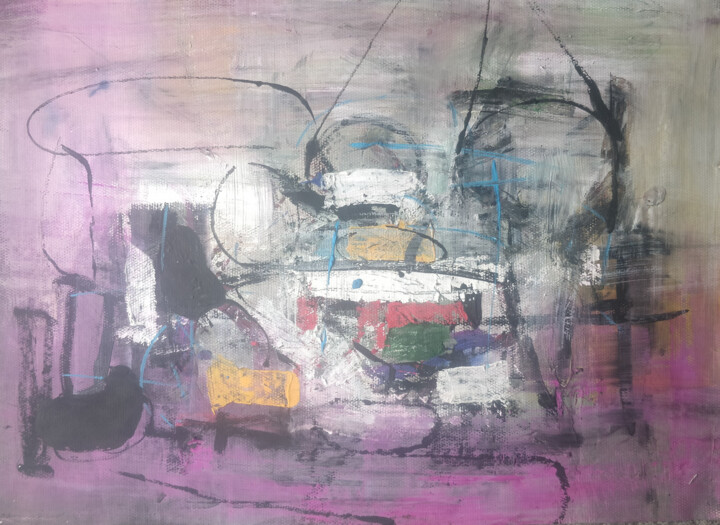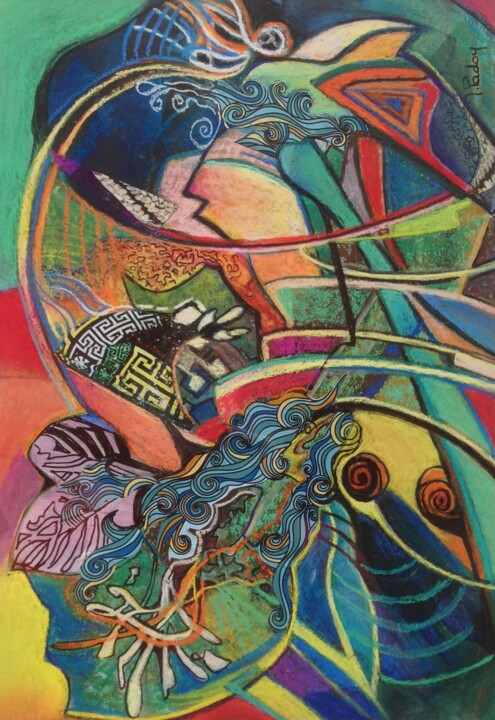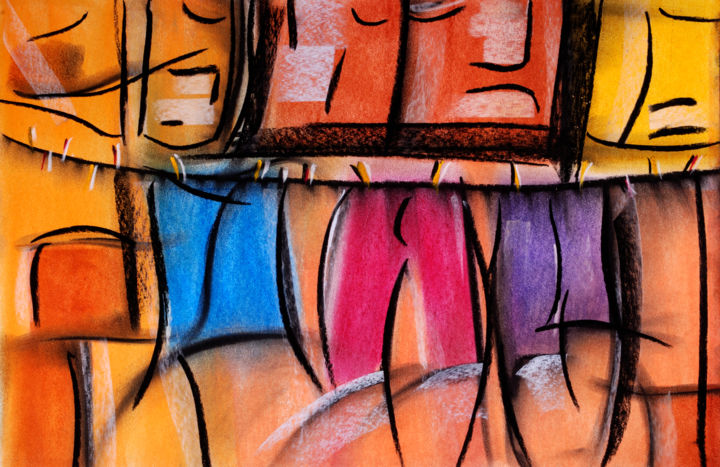3 出售原画:
时尚 ”为主题的艺术品
正如流行歌星大卫鲍伊在他的歌曲“时尚”中所说的那样,时尚在我们的生活中无处不在,无论是在我们的着装风格还是在我们的思维方式中。时尚和艺术是两个相辅相成的领域,都对高品位、别致和与众不同的事物充满热情。热爱时尚和潮流的艺术家尤其喜欢用时装屋造型师指定的漂亮礼服来代表华丽的顶级模特,为最伟大的女装设计师画衣服,以代表优雅。帽子、珠宝、香水、时尚配饰、时尚的所有元素都在我们在 Artmajeur 上精选的时尚画作中提供给您。
你在找原画出售吗?
探索所有风格和所有绘画技巧:当代绘画、街头艺术、抽象艺术、具象艺术、风景、肖像、静物、裸体、水彩、油画、丙烯画…… 20 年来,有超过 200 万件当代艺术作品有待发现……或收藏!当代绘画的世界标杆。发现来自世界各地的当代艺术家的作品,用一流的方式装饰您的室内!单纯的艺术爱好者还是公认的收藏家?找到最喜欢的画布或绘画,真正增强您的装饰效果。 Artmajeur 为您提供世界上最优秀的当代艺术家的原创作品、限量版和艺术版画。在 Artmajeur 上,这些画作是由艺术市场的爱好者和专家挑选出来的。我们为您精选时尚、获奖、知名画家的原创作品,以及当代艺术领域的新兴价值,为您在线购买画作提供指导和帮助。
如何在网上购买粉彩画?
因此,您决定在线购买粉彩画而不是丙烯酸或油画布。你有一个要检查的问题列表。
您需要过滤网络上的大量报价,并考虑它会进入什么样的房间。
如果您正在寻找一种独特的粉彩来装饰您的卧室、客厅或餐厅,何不购买粉彩艺术品呢?您可以获得各种不同风格、颜色和尺寸的粉彩。使用的帆布类型以及使用的纸张也会影响价格。粉彩是更传统油漆的一种很好的明亮替代品。
粉彩画是一种利用多种色调来创造深度和美感的艺术品。它是一种艺术形式,它在图片表面使用白色或粉红色等浅色,以操纵光线和空间,因此它们可以在不严重依赖黑色颜料的情况下表现出物体的特征。它还具有在必要时能够轻松与其他颜料混合的优点,因为它在应用到纸张或织物上后会很快变干。
购买粉彩画的另一个好处是它们不受天气条件的影响。颜料对温度和湿度的变化非常敏感,因此在热阁楼上的绘画看起来不会像在寒冷的地下室中那样。画布的重量也会影响这幅画的老化程度。它越重,它就会越老。
用于绘画的粉彩质量最好的是干粉彩。它们有多种颜色和厚度可供选择。干燥的粉彩仍然可以在画布上使用,但艺术家需要获得合适的厚度才能获得最佳效果。
当您在线购买绘画艺术品时,您还需要知道如何正确悬挂画布。许多艺术家会建议您先将画布挂在墙上,然后再悬挂。这可确保绘画保持直立位置。
如果您购买厚边有点短的画作,则应确保以不会对画布施加压力的方式悬挂画布。例如,当你在厨房的墙上挂一幅画时,你不应该试图支撑画布的末端。这会损坏画布。您还应该避免将艺术品悬挂在离散热器太近的地方。这可能会导致画布背面变色。
在线购买艺术品时,要考虑艺术品的重量。如果您从任何网站购买,您需要确保运费合理。在支付任何费用之前确定帆布的重量是明智的。
总的来说,在线购买用粉彩制作的绘画是一个很好的艺术选择。粉彩已经存在了几个世纪,并为大多数艺术鉴赏家所接受。这使它们成为在线购买绘画的绝佳方式,并且有多种款式可供选择。当您购买一幅画时,粉彩是一种很好的媒介,因为它们看起来不错并且非常易于使用。只要您确保获得高质量的绘画并有保证,那么您就可以毫无问题地获得完美的作品。
粉彩画是近年来最受欢迎的艺术类型之一。粉彩是由粉笔、颜料和水在纸或织物上的混合物制成的。它们通常可以作为具有美丽色彩的图画,让人感觉良好。
一个人可能会认为在观看粉彩画时他们已经看到了艺术品的所有可能类型,但总会有新的东西出现,比如艺术家在边缘添加金箔的趋势,这确实使这些作品脱颖而出!
如果您在空闲时间浏览网页,您将看到大量报价,您需要根据您的颜色品味和价格范围对其进行过滤。
这里有一组问题需要检查以帮助您做出最终决定
- 粉彩是用铅笔,刷子涂抹的?
- 我应该买画布上的画而不是纸上的画吗?
- 绘画主题的哪个选择,例如肖像或风景或抽象......?
- 艺术家传记和其他出售的艺术品怎么样?
- 艺术品有签名吗?
- 这幅画是否附有画框?
- 价格可以商量吗?
- 艺术品可以快速发货吗?
- 运费包含在我的位置吗?
- 退货政策是什么?
在 Artmajeur,您可以在线查看和购买数千幅粉彩画中的独特艺术品,并向我们的支持团队索取任何主题的信息。
Discover contemporary artworks on Artmajeur
Contemporary art is a vibrant constellation of artistic expressions. This creative universe encompasses a wide array of mediums, from paintings, sculpture, and photography to drawing, printmaking, textile art, and digital art, each medium a star shining with its own distinct radiance. Artists use diverse supports and materials to bring their visions to life, such as canvas, wood, metal, and even innovative digital canvases for the creation of virtual masterpieces.
A contemporary painting, for instance, may weave its story through the masterful strokes of acrylic or oil, while a contemporary sculpture might sing its song in the language of stone, bronze, or found objects. The photographic arts capture and manipulate light to produce striking images, while printmaking employs techniques like lithography and screen-printing to produce multiples of a single, impactful image. Textile art plays with fabrics and fibers, whereas digital art pushes the boundaries of creation with innovative technology.
The allure of contemporary art lies in its boundary-pushing nature, its relentless quest for experimentation and its constant reflection of the evolving human experience. This boundless creativity, coupled with its strong social and personal commentary, makes every piece of contemporary art a unique emblem of its time, a mirror held up to the realities and dreams of our complex world. It whispers to us, moves us, provokes thought, and kindles a deep emotional response, stirring the soul of anyone willing to listen. It is, indeed, the language of emotions and ideas, spoken in the dialect of our era.

©2020 Yang Youpeng
Origins and history of contemporary art
The story of contemporary art unfolds in the mid-20th century, marked by seismic shifts in artistic expression. Post-World War II, around the 1950s and 1960s, artists began experimenting beyond traditional confines, challenging the norms of what art could be. This revolutionary epoch birthed myriad new movements and artistic forms such as abstract expressionism, pop art, and minimalism. Paintings, once confined by realism, embraced abstraction, as artists used color and form to express emotions and ideas. Notable periods like the advent of pop art in the late 1950s and early 1960s saw artworks mimicking popular culture and mass media, reflecting society’s shifting focus.
The sculptural arts, too, witnessed a metamorphosis. Sculptors started to experiment with new materials and forms, often creating artworks that interacted with the viewer and the surrounding space, fostering a sense of engagement. Drawing, a timeless practice, also evolved, with artists incorporating innovative techniques and concepts to redefine its role in contemporary art.
Photography, a relatively new medium, emerged as a powerful tool in the contemporary art landscape. Born in the 19th century, it truly came into its own in the latter half of the 20th century, blurring the lines between fine art and documentation. Printmaking, a practice dating back to ancient times, saw renewed interest and experimentation with techniques like lithography, etching, and screen printing gaining prominence.
The realm of textile art expanded dramatically, as artists began to appreciate the versatility and tactile quality of fabric and fibers. Artists began using textiles to challenge the boundaries between fine art, craft, and design.
The dawn of digital technology in the late 20th century heralded a new age for contemporary art. Digital art emerged as artists started leveraging new technologies to create immersive, interactive experiences, often blurring the line between the virtual and the physical world.
Through these transformative periods, the essence of contemporary art has remained the same: a dynamic, evolving reflection of the times we live in, continually pushing boundaries and embracing the new, always questioning, always exploring.

©2017 Michèle Padoy
Evolutions of theses contemporary works in the art market
As we navigate through the 21st century, the dynamic landscape of contemporary art continues to evolve and expand, reflecting our ever-changing world. Contemporary paintings, once primarily confined to two-dimensional canvases, now embrace a multitude of forms and techniques, ranging from mixed media installations to digital creations, each piece a rich a weaving of thoughts, emotions, and narratives. Sculpture, too, has ventured far beyond traditional stone and bronze, with artists incorporating light, sound, and even motion, embodying the ephemerality and flux of the modern world.
Photography, in the hands of contemporary artists, has expanded its horizons, seamlessly blending with digital technology to create breathtaking imagery that challenges our perception of reality. Drawing, as well, has transcended the borders of paper, incorporating multimedia elements and exploratory techniques to redefine its role in the artistic discourse. Printmaking continues to flourish, with contemporary artists using traditional methods in innovative ways to deliver potent social and personal commentaries.
Textile art, once considered a craft, now holds a prominent place in the contemporary art world, with artists using it to explore issues of identity, tradition, and cultural heritage. Meanwhile, digital art, the newest member of the contemporary art family, has revolutionized the way we create and interact with art, presenting immersive experiences that blur the boundary between the virtual and the physical.
These diverse forms of contemporary art hold significant value in the current art market, not only due to their aesthetic appeal but also their ability to encapsulate and communicate complex ideas and emotions. Collectors, curators, and art lovers worldwide seek these works, drawn to their inherent dynamism, their innovative use of materials, and their eloquent expressions of our shared human experience. As a testimonial to our times, these contemporary artworks encapsulate the pulse of our society and the resonance of individual voices, forever etching our collective narrative into the annals of art history.

©2002 Chris Schäfer
Famous Contemporary Artists
As we delve into the vibrant realm of contemporary art, we encounter an array of artists who shape this dynamic field. Each a master in their medium - painting, sculpture, photography, drawing, printmaking, textile, or digital art - they push artistic boundaries, reflecting our era and challenging perceptions. Let’s explore these remarkable contributors and their groundbreaking works.
1. Gerhard Richter - Known for his multi-faceted approach to painting, Richter challenges the boundaries of the medium, masterfully oscillating between abstract and photorealistic styles. His works, whether featuring squeegee-pulled pigments or blurred photographic images, engage in a fascinating dialogue with perception.
2. Jeff Koons - A significant figure in contemporary sculpture, Koons crafts monumental pieces that explore themes of consumerism, taste, and popular culture. His iconic balloon animals, constructed in mirror-polished stainless steel, captivate with their playful yet profound commentary.
3. Cindy Sherman - An acclaimed photographer, Sherman uses her lens to explore identity and societal roles, particularly of women. Renowned for her conceptual self-portraits, she assumes myriad characters, pushing the boundaries of photography as a medium of artistic expression.
4. David Hockney - Hockney, with his prolific output spanning six decades, is a pivotal figure in contemporary drawing. His bold use of color and playful exploration of perspective convey an intoxicating sense of joy and an unabashed celebration of life.
5. Kiki Smith - An innovative printmaker, Smith’s work explores the human condition, particularly the female body and its social and cultural connotations. Her etchings and lithographs speak to universal experiences of life, death, and transformation.
6. El Anatsui - A master of textile art, Anatsui creates stunning tapestry-like installations from discarded bottle caps and aluminum scraps. These shimmering, flexible sculptures blend traditional African aesthetic with contemporary art sensibilities, speaking to themes of consumption, waste, and the interconnectedness of our world.
7. Rafael Lozano-Hemmer - A leading figure in digital art, Lozano-Hemmer utilizes technology to create interactive installations that blend architecture and performance art. His work, often participatory in nature, explores themes of surveillance, privacy, and the relationship between people and their environments.
Notable contemporary artworks
The contemporary art landscape is a dynamic patchwork of diverse expressions and groundbreaking ideas, each artwork a unique dialog with its audience. Here are a selection of some renowned contemporary artworks, spanning various media such as painting, sculpture, photography, drawing, printmaking, textile art, and digital art, that have profoundly influenced this vibrant movement.
"Cloud Gate" by Anish Kapoor, 2006 - This monumental stainless steel sculpture, also known as "The Bean," mirrors and distorts the Chicago skyline and onlookers in its seamless, liquid-like surface, creating an interactive experience that blurs the line between the artwork and the viewer.
"Marilyn Diptych" by Andy Warhol, 1962 - An iconic piece of pop art, this silkscreen painting features fifty images of Marilyn Monroe. Half brightly colored, half in black and white, it reflects the dichotomy of celebrity life and its influence on popular culture.
"Rhein II" by Andreas Gursky, 1999 - This photographic artwork, a digitally-altered image of the Rhine River, is celebrated for its minimalist aesthetic. It strips the landscape to its bare essentials, invoking a sense of tranquility and vastness.
"Black Square" by Kazimir Malevich, 1915 - A revolutionary painting in the realm of abstract art, this piece, featuring nothing more than a black square on a white field, challenges traditional notions of representation, symbolizing a new era in artistic expression.
"Puppy" by Jeff Koons, 1992 - This giant sculpture, a West Highland Terrier blanketed in flowering plants, explores themes of innocence, consumer culture, and the interplay between high art and kitsch. It’s a delightful blend of traditional sculpture and garden craft.
"Re-projection: Hoerengracht" by Ed and Nancy Kienholz, 1983-1988 - A room-sized tableau representing Amsterdam’s red-light district, this work combines elements of sculpture, painting, lighting, and found objects. It engages viewers in a stark commentary on commodification and objectification.
"Untitled" (Your body is a battleground) by Barbara Kruger, 1989 - This photomontage, combining black-and-white photography with impactful text, explores issues of feminism, identity, and power. Its potent, confrontational message is a prime example of the power of text in contemporary visual art.
"For the Love of God" by Damien Hirst, 2007 - This sculpture, a platinum cast of a human skull encrusted with 8,601 diamonds, probes themes of mortality, value, and the human fascination with luxury and decadence. It’s a compelling blend of macabre and magnificence.
"Physical impossibility of Death in the Mind of Someone Living" by Damien Hirst, 1991 - This artwork, featuring a tiger shark preserved in formaldehyde, blurs the line between traditional sculpture and biological specimen. It prompts viewers to contemplate mortality and nature’s ferocity.
"One and Three Chairs" by Joseph Kosuth, 1965 - A piece of conceptual art, it presents a physical chair, a photograph of a chair, and a dictionary definition of a chair, thus exploring the relationship between language, picture, and referent in art.
These pieces, in their diversity, exemplify the rich tapestry of contemporary art, each piece a unique commentary on our world and a testament to the limitless potential of creative expression.



